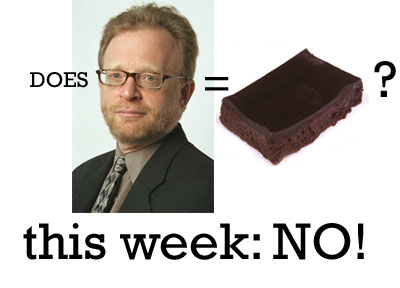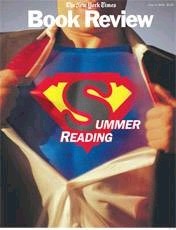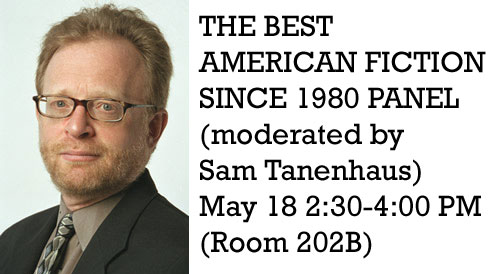
It reappeared, as if from a silly dream. Or perhaps in Mr. Tanenhaus’s case, an honest nightmare he thought was over.
WEEKLY QUESTION: Will this week’s NYTBR reflect today’s literary and publishing climatet? Or will editor Sam Tanenhaus demonstrate yet again that the NYTBR is irrelevant to today’s needs? If the former, a tasty brownie will be sent to Mr. Tanenhaus’ office. If the latter, the brownie will be denied.
To determine this highly important question for our times, three tests will be conducted each week, along with ancillary commentary concerning the content.
THE COLUMN-INCH TEST:
Fiction Reviews: 4 full-page reviews, 5 half-page reviews. (Total books: 10. Total space: 6.5 pages.)
Non-Fiction Reviews: 5 one-page reviews, 2 half-page reviews. (Total books: 7. Total space: 6 pages.)
For those who remember the old game, in order to earn his brownie point, Tanenhaus must offer a 48% minimum of review coverage to fiction. Blurbs do not count. Comparative reviews do.
Amazingly, despite the mystifying coverage granted to Jackie Collins’ Lovers & Players, in which Collins, Hackneyed be her middle name, is characterized as some faithful and possibly misunderstood observer of Californian culture, Tanenhaus just beats out the number, garnering 54.1% of the coverage.
Brownie Point: EARNED!
Alas, the attention paid to Collins, complete with a photograph labeled “Jackie Collins and Jaguar,” as if a vehicle obtained with puerile and materialistic impulses is somehow pertinent to understanding Collins’ work as a novelist (though, of course, one can hazard associative clues), detracts from these hard-won inches. And so Mr. Tanenhaus easily earns a bitchslap.
BROWNIE BITCHSLAP FACTOR: Jackie Collins? Must you contribute to furthering an east wing on Ms. Collins’ palatial estate? How, by any stretch of the imagination, can Jackie Collins be qualified as literature? SLAP! (Minus .6 points.)
THE HARD-ON TEST:
This test concerns the ratio of male to female writers writing for the NYTBR.
Of the women reviewing fiction, it seems Tanenhaus’s continuing homage to pre-Susan B. Anthony America of chicks reviewing chicks (including Jackie Collins) still holds true, with the major literary title written by a woman (Deborah Eisenberg) going to Ben Marcus. I wonder if Tanenhaus was even aware of the irony in referencing Marcus’ most recent novel, Notable American Women, in his accompanying bio. Because from where I’m sitting, notable women simply aren’t that much of a concern in the NYTBR. The bio may as well have read, “Ben Marcus has a dick and Joyce Carol Oates does not. Hence, we assigned him this review.”
The nonfiction offering is even more dreadful, with six of the seven reviews going to men (including that indefatigable blowhard David Brooks) and only Alexandra Starr garnering a nonfiction title called, yes you guessed it, Lighting the Way: Nine Women Who Changed Modern America.
One would think that the recent passing of Betty Friedan and Wendy Wasserstein might have reminded Mr. Tanenhaus that, contrary to recent Supreme Court justice nominations, women can in fact write and think too. But I suppose Tanenhaus was too busy enjoying sherry with Bill Keller at the private men’s club, presumably after a long day of deer hunting and chewing venison.
Brownie Point: DENIED!
THE QUIRKY PAIR-UP TEST:
With the exceptions of Ben Marcus, Regina Marler and maybe James Gorman, none of the reviewers have been matched with anything approaching a quirky pair-up. Yes, give Pankaj Mishra the Indian novel! He’s Indian, right? We have the usual gang of dependable Gray Lady staffers. David Brooks, Jonathan Freedland, Jim Holt. Yawn.
Brownie Point: DENIED!
CONTENT CONCERNS:
Dan Chiasson’s first several sentences are preposterous. “This is an American tale, a very American tale.” This is trying to pad your word count, Dan, desperately trying to pad your word count. Between this and such ridiculous observations as, “One of the pleasures of reading the novel is experiencing its sheer variety of actual things.” Really, Dan? Thank you for that groundbreaking statement! I mean, hell, the next thing Chiasson will be telling us is that reading a novel also allows you to get from the beginning to the end of a book. No Brownie Bitchslap Factor here. Chiasson’s review is too unintentionally entertaining.
Leave it to David Brooks to offer an equally jejune paragraph: “These men, the psychiatrists concluded, had suffered a stunning mental shock in captivity. In the extreme environment of a P.O.W. camp, their minds had been altered.” You know, I’m no psychiatrist, but I can definitely offer you the same conclusion after about ten drinks and a three-paragraph summary of the book. Brooks’ review does terrible injustice to Rebecca Lemov’s World as Laboratory, a book that, quite interestingly, deals with cognitive readjustment through psychiatric experiments of varying degree. Of course, reading Brooks’ review, you wouldn’t know what Lemov’s level of research or scholarship was — in large part because Brooks himself seems to be having great difficulty understanding the concept. Perhaps Brooks is too busy maintaining that sturdy neocon carapace of denial about Guantanamo Bay. Bobos in Paradise? Try Bozo on Page 9.
While Ben Marcus’s review seems strangely concerned with cinematic parallels over literary ones, unlike Chiasson and Brooks, he cuts straight to the point and managed to gush without fawning too much. Pankaj Mishra’s review is similarly taut. But one ponders if these two reviewers were pushed harder or were allowed to flex their respective critical acumen rather than summarizing a book. (Mishra, for example, offers an interesting thesis pointing out that a novel set in the 1980s might better understand life after 9/11. But he seems unwilling or unable to follow through on this.)
Jim Holt’s review of Happiness: A History is fun and accessible. Chelsea Cain’s review of the Waldman novel isn’t granted enough space to ask whether Waldman follows through on how society expects women to conform.
As for Ms. Sittenfeld’s article, which many of you have emailed me about, the short answer is: Methinks she doth protest too much.
But here’s the long and more inflammatory answer: Aside from the fact that Sam Tanenhaus has ignobly bankrolled an article that is tantamount to a LiveJournal bitchfest, I’ve met very few writers who are so hubristic enough to accept that their idea of the novel as the only one that matters. Certainly, most writers are defensive by nature. And this is understandable. Because it’s a tough, lonely and backbreaking business. But just as the wisest humans understand that their life view isn’t the only one that matters, the smartest writers realize that their own views of their work aren’t the singular reference point. Is it not the writer’s function to just shut the hell up and listen when someone is being kind enough to offer a hard and honest take on their novel instead of the predictable flattery? Is it not the writer’s function not to take any of these thoughts personally?
Most authors have suggested to me that the perspectives they hear from others are not only of immense value to them as artists, but, much as teachers often learn more than students do in the classroom, I suspect that an author learns much about her work from what a thoughtful and erudite person has to say, or even how a less literary person grasps the story.
Perhaps I’ve been lucky. Or perhaps the reality here is that Ms. Sittenfeld simply has no appetite for ambiguity or varying opinions, much less any interest in evolving as an artist. It’s absolutely paralogical for any serious writer to state, “It’s pretty obvious that some readers say they hate your protagonist as a more polite way of saying they hate your entire book, but when I want to hear from people who hate my book, I prefer doing it in the comfort of my own home by looking at customer reviews on Amazon.” Such a sentence assumes not only a remarkably conspiratorial opinion of the human race, but it also implies that writing should be easy and effortless.
Cry me your body mass in tears, Curtis.
Writing sure as hell isn’t easy. If writing a novel were as simple as slapping together a sandwich, then we’d be up to our arms and legs with books. Because everybody would be doing it. (And by doing it, I mean getting the sucker published and sold.) Furthermore, given that the customer reviews on Amazon are — how shall we say this exactly? — mostly incohrent and toothless drivel written by slavish fanboys, how can any writer worth her salt hone her wares by customer reviews alone?
Is it possible that the NYTBR‘s climate has grown so solipsistic and singular in thought that these precious gray areas are not allowed to germinate? Sittenfeld might have had a hell of an essay if a less sycophantic editor actually challenged her to come to terms with how other people view her novel, exploring whether any of this has might make her a better novelist. Instead, and this is not necessarily a judgment of her character — I don’t know the woman — but rather the perception I get from the essay, she comes across as a drama queen of the lowest order.
CONCLUSIONS:
Overall, as the NYTBR goes, this isn’t too bad of an issue. But it’s far from consistent. Tanenhaus’s recidivist reviewing pairup are uncalled for in the 21st century. And there are still troubling concerns in tone.
Brownie Points Earned: 1
Brownie Points Denied: 2
Brownie Bitchslap Factor: -.6 points
TOTAL BROWNIE POINTS REQUIRED FOR BROWNIE DELIVERY: 2
TOTAL BROWNIE POINTS EARNED: .4 points

[UPDATE: For another take on this issue, see Levi Asher’s.]
 Well, I thought I was done with Sam Tanenhaus. But it appears that I’m not. This is simply too good to pass up. The image to the right is the cover that the NYTBR is issuing for its June 3, 2006 issue, which is designated as its “Summer Reading” issue. And what does that mean? Reviews of books from Martha McPhee, Plum Sykes, Scott Anderson and Sara Gruen. Yup. Real heavy-duty fiction.
Well, I thought I was done with Sam Tanenhaus. But it appears that I’m not. This is simply too good to pass up. The image to the right is the cover that the NYTBR is issuing for its June 3, 2006 issue, which is designated as its “Summer Reading” issue. And what does that mean? Reviews of books from Martha McPhee, Plum Sykes, Scott Anderson and Sara Gruen. Yup. Real heavy-duty fiction.




 You might call me a heartless tycoon. But I’m smarter and better than you. Feelings are the stuff that I reserve for scoundrels named Mark Singer, whose liver I am now using to wipe the floor of one of my many apartments. Let that be a lesson to my critics.
You might call me a heartless tycoon. But I’m smarter and better than you. Feelings are the stuff that I reserve for scoundrels named Mark Singer, whose liver I am now using to wipe the floor of one of my many apartments. Let that be a lesson to my critics. Leiter suggests that Vollmann “bizarrely ascribes” a “realism” to Nietzsche and suggests that Nietzsche does not hold the view that “cruelty is innate,” complaining that Vollmann fails to cite a specific passage. I’m fairly certain that Vollmann was suggesting one of Nietzsche’s most infamous statements from Thus Spake Zarathrusta, something that a certain Austrian perhaps took too much to heart: “Man is the cruelest animal. Whatever is most evil in his best power and the hardest stone for the highest creator.” Far from a “People magazine speculation,” Vollmann is willing to give the NYTBR readership the benefit of the doubt, presuming that they are familiar with Nietzsche’s basics. Further, Vollmann framed the “realism” within quotes, leaving little question to the reader that this was a speculation on Nietzsche’s capacity to tell the truth about the human race. This commonality, of course, what separates Vollmann’s work from many of his contemporaries on both the fiction and the nonfiction fronts.
Leiter suggests that Vollmann “bizarrely ascribes” a “realism” to Nietzsche and suggests that Nietzsche does not hold the view that “cruelty is innate,” complaining that Vollmann fails to cite a specific passage. I’m fairly certain that Vollmann was suggesting one of Nietzsche’s most infamous statements from Thus Spake Zarathrusta, something that a certain Austrian perhaps took too much to heart: “Man is the cruelest animal. Whatever is most evil in his best power and the hardest stone for the highest creator.” Far from a “People magazine speculation,” Vollmann is willing to give the NYTBR readership the benefit of the doubt, presuming that they are familiar with Nietzsche’s basics. Further, Vollmann framed the “realism” within quotes, leaving little question to the reader that this was a speculation on Nietzsche’s capacity to tell the truth about the human race. This commonality, of course, what separates Vollmann’s work from many of his contemporaries on both the fiction and the nonfiction fronts.
